By Jeanne Bacigalupo
Helen had finished tenth grade, then
completed enough training at the business school to venture out
on her own. She was still sixteen years old when she went to work
at a real estate
office in Killam, Alberta for eight or nine months. From there,
she went to work at the old Merchant’s Bank of Canada in the
town of Alliance in Alberta. She was twenty years old when she
moved to Seattle for about two years. It may have been at that
time that she took a car trip to California with two other girls
and a man who was a relative. He had previously taught her to
drive. The car didn't go much over forty miles per hour
comfortably but she had it up to fifty miles in order to pass
another vehicle. It took them four days to get to California.
When Helen first moved to Seattle,
she lived with her Aunt Ethel Thomson who was pregnant. Helen
helped her Aunt for three weeks until Val Thomson was born. Her
new job involved using a typewriter, an adding machine and
sending checks to a clearinghouse. She shared an apartment with
Mary Ince, her second cousin, and the daughter of Theo and Jessie.
Theo was the son of Auntie 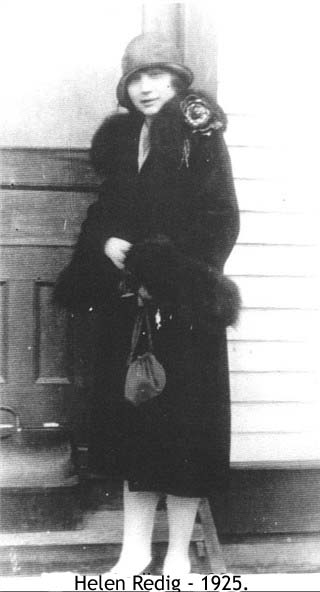 Darling. (See the picture of the house in
which he was born, Springfield Ill.)
Darling. (See the picture of the house in
which he was born, Springfield Ill.)
It was two years before Helen moved from Seattle to a place called Penhold, near Calgary, where she worked in the Bank of Montreal for three years. She then moved to Calgary where she worked for eighteen months before marrying Frank Richter. He was born in Germany into a wealthy family; his father was a medical doctor, and was very kind to Frank and his new family. Frank had been drafted into the German army when he was just seventeen years old. It was World War I, (1914 -1918) and he served for two years and seven months. He was wounded three times, a knee injury, a stomach injury and a neck and head injury from shrapnel; the wounds affected him the rest of his life. Before they were married, he spent one winter by himself on the Kootenay property.
In 1930 Frank and Helen moved to a
small cabin on the property in the beautiful Kootenay area of
British Colombia, where they would live for fifteen years except
for the times that Helen was away for the births of her children.
There was no electricity and the water had to be carried quite a
distance up the hill to the cabin. At that time, there was just
one large room (twenty by twenty four feet) in the cabin. A
double bed, a table, two or three old wooden chairs and two
benches were the extent of their furniture. An old trapper, who
lived a couple of miles away, built some shelves behind the cabin
door where Helen could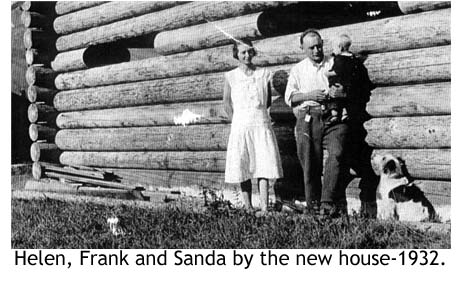 store a few of her kitchen things. There was
just one little cupboard, no counter-top, or drawers, only a
couple of nails to hang a potato masher and an eggbeater. She
washed her dishes in a dishpan on the table, with the water that
she carried up the hill, and heated on the wood-burning stove.
The firebox was partly burned out; when she baked her bread and
buns, some of the ashes fell into the oven and onto the bread.
Later, a better stove and a good floor were installed in the
little home.
store a few of her kitchen things. There was
just one little cupboard, no counter-top, or drawers, only a
couple of nails to hang a potato masher and an eggbeater. She
washed her dishes in a dishpan on the table, with the water that
she carried up the hill, and heated on the wood-burning stove.
The firebox was partly burned out; when she baked her bread and
buns, some of the ashes fell into the oven and onto the bread.
Later, a better stove and a good floor were installed in the
little home.
Frank' s father, in Germany, sent two hundred dollars every three months, until Hitler came to power in 1934. He would not permit money to be sent out of the country. From Germany also, came some mattresses and white pine furniture, a dresser and a buffet, which the family used for fourteen years.
In 1930, Frank's sister and father came from Germany to visit. Helen was three months pregnant and climbed with Frank and the others up one of the nearby mountains. When coming down, she had to sit and slide down carefully so that she would not fall. The visitors came again in 1938.
Helen was an enthusiastic gardener, growing peas, carrots and cabbage, "It was not a picnic" she said. They ate what they grew and brought onions, potatoes, and rice from the little town. In later years, she did a lot of canning of berries and vegetables. The land was too rocky and the soil too shallow to grow large potatoes; often the deer ate the carrot tops in the spring. Frank plowed a large field, grew alfalfa and oats and used a scythe to cut the crops one or two years until he was able to buy a mower. He had to stack the hay in stooks to dry it, then pitch it onto the stone boat (a heavy large sled pulled by horses) and haul it to the barn and pitch into the mow (with a pitch fork). It was a good barn (was there when they came) with room for three cows and a place for chickens. The cows and chickens had been brought across the river on the cable, the cows with ropes around their bellies and their feet hanging down over the water. The horses came later in June and July when the water was low. Helen said that she forded the river once, on a horse; the water was up to the "arm pits" of the horses; the river was wider than one hundred twenty-five feet and the bottom was very rocky.
Their meat mostly came from the game that Frank hunted, usually it was from white tailed deer. One time he had to go very high up the mountain to get a black tailed deer. There were months when they went ten days without red meat to eat. Frank trapped and sold furs in the wintertime; for a few summers, he guided hunting parties. In 1936 and 1937, he led into the mountains, two men from Texas and helped them achieve their goal, to bring back trophies which they could take home for display. They left the meat for Frank's family to consume. Sanda was about six and Diana about three years old.
While Helen was with her parents in Lacombe, at the time of Sanda's birth, Frank was building a larger log home; it had a few unfinished rooms which provided sleeping area in the summer time for visitors. The house had openings for the windows, but no glass and the family lived in the smaller enclosed part of the original cabin, which was shut off with doors. Lumber was too expensive and difficult to get across the river, thus the larger part of the cabin was never finished. Later, Frank and a helper moved a trapper's shack one-and-a-half miles, and joined it to the house. He and the trapper numbered each log and were able to put it back together properly.
Late one June night,
Helen and thirteen-month-old Sanda were being pulled across the
river on the cable car when it became stuck. Frank and two other
men worked for three long hours to repair it. Helen and Sanda sat
in the dark, very tired, hungry, cold and frightened. The mother
sang to her child to keep her calm. It was ninety feet down to
the river, and Frank and the men worked frantically. Finally, at
one o'clock in the morning the cable car moved; mother and child
were at last safely on solid ground. It was not like the modem
chair lifts today, but made by trappers many years ago. The seat,
made from planks, was about two feet wide, enough space for two
people to sit. There was a two-by-four board at each side but
nothing to lean your back against. It was like sitting on a
swing, but it took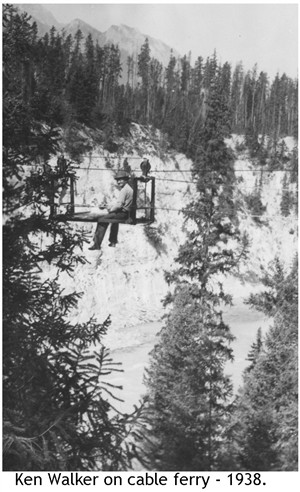 a strong man to pull a person across the
river. When Jessie came to visit, she had to wear a blindfold
before she would attempt the crossing.
a strong man to pull a person across the
river. When Jessie came to visit, she had to wear a blindfold
before she would attempt the crossing.
In 1934, Helen had been living in the Kootenay less than four years, when her parents and sister, Florence, came to visit. They were not entirely unexpected, but it was sort of a surprise. It took a long time to get mail; sometimes it was a couple of months for a letter to reach them because they had to cross the river on the cable and make the trip out of the Kootenay whenever they wanted their mail or some groceries. Frank kept an old De Soto car on the other side of the river, which they used when going to one of the, towns or to Lacombe. Helen said that she seldom went to town. At the time her visitors came, she was pregnant with her second child, Diana and had employed a woman, Mrs. Richardson, to help with the work. It was just a few weeks before birth and there were a goodly number of chickens to care for and water to haul up the hill. Mrs. Richardson, (later to become Helen's mother-in-law) worked for twelve dollars a month. She was first offered ten dollars but said; "Make it twelve and I'll come". She was worth it! She hauled the water, fixed the fire, washed the clothes on a board, and ironed, Sanda was three years old at the time.
Helen and Mrs. Richardson were out a
little way from the house, picking wild strawberries when they
heard the " toot toot " of Valentine's 1926 Oldsmobile.
Frank went down and brought them across the river on the cable.
At the time of this visit, Maude was now in her early sixties;
the cable ride didn't seem to bother her. After the cable
crossing, there was a three-quarter-mile up-hill hike to reach
the cabin. It was July when they came and the beauty of the
surrounding countryside was worth the effort. Typical, Valentine
busied himself, he repaired the stove, made its door so that it
closed properly, and made a new firebox out of an old gas or oil
can.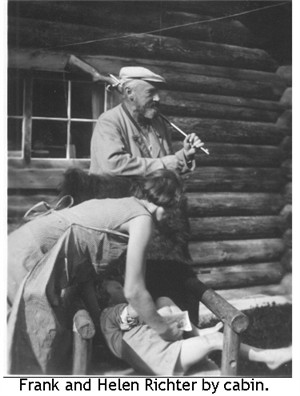
Mrs. Richardson had left earlier and it was time for the Redigs and Florence to go home. Frank took Helen out also, in order to be near a hospital for the birth. As soon as the good-byes were said, both cars across the river started travelling on the Settler’s Road, the eight miles to the highway, the Banff-Windermere Highway. When they reached the highway, Val, Maude and Florence drove toward Banff, Frank and Helen drove toward Invermere. About ten miles down the road, Valentine's car developed trouble and they had to stop. Florence had teenagers and a husband waiting at home; she flagged a car and caught a ride into Banff where she could get transportation to her home. Valentine and Maude limped their car back to the Kootenay. They had to send out for the parts for their car, which took two weeks. Boots was born at the hospital in Invermere. Helen stayed in the hospital ten days, then, with friends travelled back to the Kootenay. Boots was about two weeks old then.
In March of 1939 Sanda, Helen, Frank
and the new baby, Karl, were returning to the Kootenay from the
Redigs' home, when Sanda contracted double pneumonia. She was in
the Holy Cross Hospital in Calgary for three months and at one
time was strapped down and confined in an oxygen tent. The
experience for Sanda was very traumatic. She had her eighth
birthday in the hospital and has said that she will never forget
that time in her life. Frank, Helen, Boots and baby Karl stayed
in a hotel nearby so they could be with Sanda as much as possible.
During this time, Jessie came from Raymond to visit Helen and the
two sisters decided to go to a movie. Helen believes this is
where she caught scarlet fever and was confined in the isolation
Hospital in Calgary. Her Uncle Alf Kent and his wife Agnes lived
in Calgary; fortunately, she was able to care for Karl. Helen was
in the hospital for the last month of Sanda's stay there in the
hospital. Frank took Boots back to the Kootenay. Sanda was
released a week before Helen; a kind woman-friend of Helen's,
living on a small farm near Calgary, cared for the still weak
girl. The woman fixed her garage up so that Helen could stay
there in further isolation for ten days after she was released.
The doctors insisted on this procedure because they feared that
Sanda, in her weakened condition, could be re-infected somehow by
her mother. At the end of the ten days, Helen and Sanda collected
Karl from Agnes and they were all finally able to return to their
Kootenay home. It was now the month of July.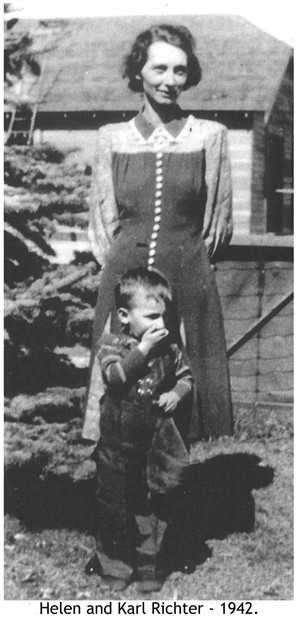
During World War II, (1939 - 1945) the Canadian government took Frank from his family because of his recent immigrant status. He was held in a camp along with many other German immigrants for about two years. They were first confined at Kananaskis, Alberta, then taken to Sudbury, Ontario and finally moved to Fredericton, New Brunswick. Helen and her children were alone for at least four months, no provisions were made for them by the government during that time. Karl, the youngest child, was just a year old. The horses, (about ten) had been given to an old trapper, a friend of Frank's and Helen's, to look after. The cow was shot and the meat was given to the meat market owner. They left the chickens. The family was given no recompense except for an eighty-three dollar check when Frank was finally released. Fortunately, it was summer time, and Helen and her Children were able to survive with their garden produce, eggs and milk from the one cow they still had. Otherwise, there was very little to eat and no one to help should an emergency arise, except perhaps a trapper a few miles away. Finally, the government moved them to a little house on the outskirts of a small town called Windermere. Helen brought the canned food she had put up during the summer. Fortunately, Mrs. Richardson's, son, Tom, helped as much as he could. Life was better, but still very difficult for Helen and her three children. Near the end of his second year, Frank required medical treatment and was taken to a hospital in Montreal. Some of the German men at the camp collected money so Helen could visit Frank. She took Karl who was now three years old, with her. Boots, then eight years old and Sanda eleven years old, stayed with friends. Frank gave Helen the name of a man in one of the Canadian Parliament Buildings who could possibly help Frank in obtaining an early release from the compound. Helen was successful and Frank came home in 1942 after two years of confinement.
The family lived in the little house in Windermere for a year and moved to a place in the country for another year. In 1944, they moved back to their Kootenay home taking with them ten cows and a bull. On horseback, Sanda, thirteen years and Diana helped with the cattle, fording the river and settling them on the new farm. In Sept. 1945, Helen and the children left the Kootenay to get the children to school in Invermere. She worked as a cook at the hospital for a few months, then in the Christmas tree yard and later in a coffee shop. She took food to Frank who was staying out at the old home so he could feed the cattle. During April 1946, they sold the Kootenay place and purchased a farm four miles from Invermere.
They lived on the Invermere farm for seven years and at one time had a herd of seventy-three whiteface beef cattle. As the calves came, the children made pets of them; every animal became friendly and tame.
Summer 1948 Arthur and Ethel Northgraves and their four children were visiting the Ricthers, having a great time riding horses, picking wild strawberries, and swimming at Fairmont Hot Springs. Sanda lived with the Northgraves in Chilliwack and attended high school for a year after which she did live-in childcare until she went back to Invermere, met and married Joe Taylor in 1952. Joe and Sanda worked very hard and were very successful growing and selling garden produce; many people wanted their fresh vegetables and fruits. Harvesting and selling Christmas trees during fall and into wintertime was another successful enterprise. Later Joe included landscaping as a sideline.
By 1953, things still were not working out at the Invermere farm for Helen. She and son Karl then fourteen years old lived with Sanda and Joe for a month, before going to Penticton. Helen worked there in a cannery for six months. During Thanksgiving, she travelled to visit her sister, Ethel, in Chilliwack, who encouraged her to stay. Helen took over the care of Maude and Val for three months to give Ethel a much needed break. Karl went back to Invermere, but stayed only three weeks. Helen found work at the army camp in Sardis, not far from Chilliwack, doing payroll and secretarial work for $150.00 a month, which seemed like a lot of money then. Ethel resumed the care of the Redigs and was able to go back to her own home evenings when Helen got off work. In January 1954, with Valentine's help, Helen was able to finance a house in Sardis and provide a home for Karl who had been living with Don and Margaret Northgraves. Boots had been living in Invennere; she also came to live with Helen. Edna, a young friend of Helen's from work, boarded there for fifty dollars a month. Boots did child care at first but soon was able to get waitress work at the officers' mess which paid one hundred fifty-five dollars a month. She was in the world of work and learned a lot.
Helen's work went well and by 1956 she was given a promotion to class three and transferred to Northern B.C. at Fort Nelson, a very cold place to live, near the Yukon border. In October 1956, Helen left Fort Nelson and went to Kamloops, and in Feb. 1958, she joined the Navy Dept. of the National Defense in Kamloops. She bought a house and Boots and Karl came to live with her. At this time, Val and Maude were in the nursing home in Calgary and Valentine was not very well. Ethel had just been blessed with a new grandchild. In a letter to Ethel, Helen describes a few of the things going on in her life. "I meant to write before this and congratulate Norma and Norm (Beer) on their big boy, wasn't it a whopper though, for a little thing like Norma. So glad he is doing fine, also the other babies, you have beaten me by a long shot, you with eight grandchildren and me with only two. I have been back from holidays and working now for three weeks. Sanda and family are just fine, kids growing and the new house is nice and comfy and handy, sure glad they are in there for the winter. They got a nice milk cow when we were there, so they will have plenty for kids and Joe to drink (he is a regular calf) and can sell cream or milk if they like. She cost almost $200 and is a dandy, real big, mostly black, some white and very gentle. In addition in town, at least it didn't stay, but out here in the hills, it was all white, but is gradually going this afternoon, rained in town all night.
Must close now and get ready to go home, Monday is a holiday. We had a turkey dinner here yesterday, at noon, free, from the Canteen fund, we will have another at Xmas I think, usually 2 or 3 a year. Have been taking big bouquets of dark rose asters home on week ends, they have beautiful flowers out here and now they will soon be gone, seems too bad to see them all bent over with the snow and no one picking them. I also have a bouquet in the office. So long and write again- soon, nice to hear all the news. Love to all, Helen.